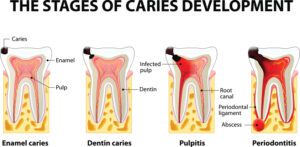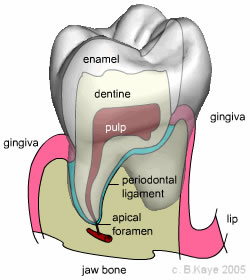Introduction
The periodontal ligament (PDL) is an often-underappreciated hero in dental health. While teeth steal the spotlight, the PDL quietly works behind the scenes, playing a crucial role in maintaining stability and supporting overall dental health.
Structure of Periodontal Ligament
Imagine the PDL as a flexible yet resilient network, composed of collagen fibers, blood vessels, and cells. This intricate structure acts as a dynamic anchor, allowing for tooth movement and adaptation to various pressures during activities like chewing.
- Collagen Fibers:
Building Blocks: Collagen makes up the main structure, providing a balance of flexibility and strength for tooth stability.
- Blood Vessels:
Supply Network: Rich in blood vessels, the PDL gets nutrients and oxygen, supporting its health.
- Cells:
Fibroblasts: Specialized cells that create collagen and maintain the ligament.
Cementoblasts and Osteoblasts: Cells helping to build and maintain tooth-supporting structures.
- Nerve Endings:
Sensory Role: Nerve endings allow you to feel pressure on your teeth, such as during biting or chewing.
- Ground Substance:
Fluid-Filled Matrix: A gel-like substance that cushions and protects the teeth from shocks.
- Sharpey’s Fibers:
Anchors: Collagen bundles that anchor the tooth to the surrounding bone and cementum.
Role in Dental Health
The PDL’s attachment to both the tooth and the alveolar bone is essential for providing support. This attachment enables minor tooth movement, ensuring proper alignment and preventing issues such as overcrowding. Essentially, the PDL is the unsung architect of a stable and well-aligned dental structure.
Regulation of Tooth Movement
In the realm of orthodontics, the periodontal ligament takes center stage. Orthodontists harness the PDL’s unique property of remodeling, guiding teeth into their proper positions. Understanding this intricate dance between the PDL and orthodontic treatments is key to achieving successful outcomes.


Periodontal Ligament Diseases
Despite its resilience, the PDL is not invincible. Diseases like periodontitis and gingivitis can jeopardize its health, leading to potential repercussions for oral and systemic well-being if left untreated. Recognizing the signs and symptoms of these conditions is crucial for early intervention.
- Periodontitis
Periodontitis is a severe gum infection that damages the soft tissue and destroys the bone supporting the tooth. As the infection progresses, it can lead to the deterioration of the periodontal ligament, compromising its ability to support the tooth. Symptoms include swollen and bleeding gums, persistent bad breath, and tooth mobility. Without intervention, periodontitis can result in tooth loss and may contribute to systemic health issues.
- Gingivitis
Gingivitis is the precursor to periodontitis and represents inflammation of the gums. While it primarily affects the gums, untreated gingivitis can escalate, affecting the periodontal ligament. Common signs include red, swollen gums and bleeding during brushing. Gingivitis is reversible with proper oral hygiene practices, but if left untreated, it can progress to more severe periodontal diseases.
- Necrotizing Periodontal Diseases
This group of diseases involves the death of gum tissues, periodontal ligament, and even supporting bone. Necrotizing periodontal diseases are often associated with factors like stress, malnutrition, and compromised immune function. Symptoms include severe pain, gum ulcers, and a distinctive fetid odor. Immediate professional intervention is crucial to manage these aggressive diseases and preserve the integrity of the periodontal ligament.
- Aggressive Periodontitis
Aggressive periodontitis is a rapidly progressing form of gum disease that can affect the periodontal ligament. It typically manifests in young individuals and can lead to significant destruction of the tooth-supporting structures. Patients may experience rapid tooth loss, especially if the condition is not promptly addressed. Early detection and intervention by a dental professional are paramount to mitigate the impact on the periodontal ligament and prevent further dental complications.
- Chronic Periodontitis
Chronic periodontitis is a common form of gum disease characterized by inflammation of the supporting structures around the teeth. The chronic nature of this condition means that symptoms may come and go, making it crucial for individuals to be vigilant about their oral health. Left untreated, chronic periodontitis can result in the gradual degradation of the periodontal ligament and the supporting bone. Regular dental check-ups and consistent oral care are essential for managing this prevalent periodontal disease.


Diagnostic Techniques
Dentists employ a variety of diagnostic techniques to assess the health of the PDL. From X-rays providing a detailed look at the tooth-supporting structures to periodontal probing measuring the depth of the gum pockets, these tools aid in early detection of PDL issues. Early identification allows for prompt and effective preventive dentistry.
Importance in Dental Surgery
When it comes to dental surgeries, understanding the nuances of the PDL is paramount. Awareness of its structure and function helps mitigate risks and complications during procedures, contributing to the overall success of dental interventions. From extractions to implant placements, every surgical step considers the PDL’s role.
Periodontal Ligament Regeneration
The realm of dental research is continually exploring avenues for regenerating the PDL. Scientists are delving into ways to stimulate its regeneration, offering promising prospects for future dental treatments. The ability to regenerate the PDL could revolutionize how we approach tooth and gum health, opening new doors for personalized and effective therapies.
Maintaining Periodontal Ligament Health
Preserving the health of the periodontal ligament involves more than just regular dental check-ups, although those are crucial. Daily oral care practices, such as proper brushing and flossing, play a foundational role. Additionally, regular professional cleanings contribute to overall oral well-being by preventing the buildup of plaque and tartar that can negatively impact the PDL.
Relation to Overall Health
Research is shedding light on the interconnectedness of oral and systemic health. The condition of the PDL has been linked to conditions such as cardiovascular disease. This underscores the importance of adopting a holistic approach to oral care, emphasizing not only a healthy mouth but also its potential impact on the entire body.
Innovations in Periodontal Ligament Care
As technology continues to advance, so does the landscape of dental care. Laser therapy, 3D printing, and other technological innovations are transforming the way we approach periodontal care. These advancements pave the way for personalized treatment approaches, tailoring dental interventions to individual PDL needs for optimal results.
Patient Education on PDL
Empowering patients with knowledge about the significance of the PDL is a crucial aspect of proactive oral care. Education campaigns and initiatives that engage patients in understanding the importance of PDL health foster a sense of responsibility for their oral well-being. Informed patients are more likely to adhere to recommended dental practices, contributing to better long-term outcomes.
Future Directions in Dental Care
The field of dentistry is dynamic, with trends evolving towards minimally invasive procedures and patient-centric care. Ongoing research holds the promise of groundbreaking discoveries, potentially reshaping how we approach dental health. Keeping an eye on emerging trends ensures that both dental professionals and patients stay ahead of the curve in promoting optimal oral health.
Conclusion
At Krishees Multispeciality Dental Care, we recognize the significance of the periodontal ligament in the broader context of oral health. Our commitment to providing comprehensive dental care encompasses not only addressing immediate concerns but also promoting preventive measures and patient education. We strive to empower our patients with knowledge about maintaining PDL health, encouraging a proactive approach to their oral well-being.
Frequently Asked Questions
1. How often should I have my PDL assessed?
Regular dental check-ups, ideally every six months, include assessments of your periodontal ligament. These assessments are crucial for early detection of any potential issues.
2. Can poor diet affect the health of my PDL?
Yes, a diet lacking essential nutrients can impact PDL health. Ensuring a balanced diet with sufficient vitamins and minerals contributes to overall oral well-being, including the health of the periodontal ligament.
3. Is PDL regeneration a reality?
Ongoing research shows promise in stimulating PDL regeneration, offering potential breakthroughs in dental treatments. While not yet fully realized, the prospect holds exciting possibilities for the future of dental care.
4. What role does the PDL play in orthodontic treatments?
The PDL’s ability to remodel is leveraged in orthodontics to guide teeth into their proper positions. Understanding this dynamic process is crucial for successful orthodontic interventions.
5. How does smoking affect the periodontal ligament?
Smoking can compromise PDL health, leading to increased risks of periodontal diseases. Quitting smoking positively impacts oral well-being, supporting the overall health of the periodontal ligament.

Leave a Reply